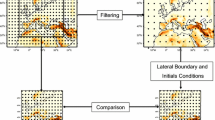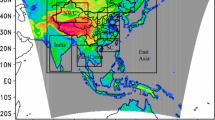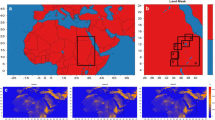Abstract
The objective of this work is to gain a general insight into the key mechanisms involved in the impact of nudging on the large scales and the small scales of a regional climate simulation. A “Big Brother experiment” (BBE) approach is used where a “reference atmosphere” is known, unlike when regional climate models are used in practice. The main focus is on the sensitivity to nudging time, but the BBE approach allows to go beyond a pure sensitivity study by providing a reference which model outputs try to approach, defining an optimal nudging time. Elaborating upon previous idealized studies, this work introduces key novel points. The BBE approach to optimal nudging is used with a realistic model, here the weather research and forecasting model over the European and Mediterranean regions. A winter simulation (1 December 1989–28 February 1990) and a summer simulation (1 June 1999–31 August 1999) with a 50 km horizontal mesh grid have been performed with initial and boundary conditions provided by the ERA-interim reanalysis of the European Center for Medium-range Weather Forecast to produce the “reference atmosphere”. The impacts of spectral and indiscriminate nudging are compared all others things being equal and as a function of nudging time. The impact of other numerical parameters, specifically the domain size and update frequency of the large-scale driving fields, on the sensitivity of the optimal nudging time is investigated. The nudged simulations are also compared to non-nudged simulations. Similarity between the reference and the simulations is evaluated for the surface temperature, surface wind and for rainfall, key variables for climate variability analysis and impact studies. These variables are located in the planetary boundary layer, which is not subject to nudging. Regarding the determination of a possible optimal nudging time, the conclusion is not the same for indiscriminate nudging (IN) and spectral nudging and depends on the update frequency of the driving large-scale fields τ a . For IN, the optimal nudging time is around τ = 3 h for almost all cases. For spectral nudging, the best results are for the smallest value of τ used for the simulations (τ = 1 h) for frequent update of the driving large-scale fields (3 and 6 h). The optimal nudging time is 3 for 12 h interval between two consecutive driving large-scale fields due to time sampling errors. In terms of resemblance to the reference fields, the differences between the simulations performed with IN and spectral nudging are small. A possible reason for this very similar performance is that nudging is active only above the planetary boundary layer where small-scale features are less energetic. As expected from previous studies, the impact of nudging is weaker for a smaller domain size. However the optimal nudging time itself is not sensitive to domain size. The proposed strategy ensures a dynamical consistency between the driving field and the simulated small-scale field but it does not ensure the best “observed” fine scale field because of the possible impact of incorrect driving large-scale field. This type of downscaling provides an upper bound on the skill possible for recent historical past and twenty-first century projections. The optimal nudging strategy with respect to dynamic downscaling could add skill whenever the parent global model has some level of skill.















Similar content being viewed by others
References
Alexandru A, de Elia R, Laprise R, Separovic L, Biner S (2009) Sensitivity study of regional climate model simulations to large-scale nudging parameters. Mon Weather Rev 137:1666–1686
Bhaskaran B, Jones RG, Murphy JM, Noguer M (1996) Simulations of the Indian summer monsoon using a nested regional climate model: domain size experiments. Clim Dyn 12:573–587
Bowden J, Otte T, Nolte C, Otte M (2012) Examining interior grid nudging techniques using two-way nesting in the WRF model for regional climate modeling. J Clim 25:2805–2823
Bukovsky MS, Karoly DJ (2009) Precipitation simulations using wrf as a nested regional climate model. J Appl Meteorol Climatol 48:2152–2159
Caldwell P, Chin HNS, Bader DC, Bala G (2009) Evaluation of a WRF dynamical downscaling simulation over California. Clim Change 95:499–521
Castro C, Pielke Sr R, Leoncini G (2005) Dynamical downscaling: assessment of value retained and added using the regional atmospheric modeling system (RAMS). J Geophys Res 110:D05108. doi:10.1029/2004JD004721
Claud C, Alhammoud B, Funatsu BM, Lebeaupin-Brossier C, Chaboureau JP, Béranger K, Drobinski P (2012) A high resolution climatology of precipitation and deep convection over the mediterranean region from operational satellite microwave data: development and application to the evaluation of model uncertainties. Nat Hazards Earth Syst Sci 12:785–798
Crétat J, Pohl B, Richard Y, Drobinski P (2012) Uncertainties in simulating regional climate of southern africa: sensitivity to physical parameterizations using WRF. Clim Dyn 38:613–634
Davies HC, Turner RE (1977) Updating prediction models by dynamical relaxation: an examination of the technique. Q J R Meteorol Soc 103:225–245
De Elia R, Laprise R, Denis B (2002) Forecasting skill limits of nested, limited-area models: a perfect-model approach. Mon Weather Rev 130:2006–2023
Denis B, Laprise R, Caya D, Côté J (2002) Downscaling ability of one-way nested regional climate models: the Big-Brother experiment. Clim Dyn 18:627–646
Denis B, Laprise R, Caya D (2003) Sensitivity of a regional climate model to the resolution of the lateral boundary conditions. Clim Dyn 20:107–126
Déqué M, Piedelievre J (1995) High-resolution climate simulation over Europe. Clim Dyn 11:321–339
Di Luca A, de Elía R, Laprise R (2012a) Potential for added value in temperature simulated by high-resolution nested RCMs in present climate and in the climate change signal. Clim Dyn 1–22. doi:10.1007/s00382-012-1384-2
Di Luca A, de Elia R, Laprise R (2012b) Potential for added value in precipitation simulated by high resolution nested regional climate models and observations. Clim Dyn 38:1229–1247
Drobinski P, Flamant C, Dusek J, Flamant P, Pelon J (2001) Observational evidence and modeling of an internal hydraulic jump at the atmospheric boundary layer top during a tramontane event. Boundary Layer Meteorol 98:497–515
Drobinski P, Bastin S, Guénard V, Caccia J, Dabas A, Delville P, Protat A, Reitebuch O, Werner C (2005) Summer mistral at the exit of the Rhône valley. Q J R Meteorol Soc 131:353–375
Drobinski P, Béranger K, Ducrocq V, Allen J, Chronis G, Font J, Madec G, Papathanassiou E, Pinardi N, Sammari C, Taupier-Letage I (2009a) The HYMEX (hydrological in the mediterranean experiment) program: the specific context of oceanography. Mercator Newslett 32:3–4
Drobinski P, Ducrocq V, Lionello P, The HyMeX ISSC (2009b) Hymex, a potential new CEOP RHP in the mediterranean basin. GEWEX Newslett 19:5–6
Drobinski P, Ducrocq V, Lionello P (2010) Studying the hydrological cycle in the mediterranean. EOS Trans Am Geophys Union 91:373
Drobinski P, Ducrocq V, Lionello P, Homar V (2011) Hymex, the newest GEWEX regional hydroclimate project. GEWEX Newslett 21:10–11
Drobinski P, Anav A, Lebeaupin-Brossier C, Samson G, Stéfanon M, Bastin S, Baklouti M, Béranger K, Beuvier J, Bourdallé-Badie R, Coquart L, D’Andrea F, De Noblet-Ducoudré N, Diaz F, Dutay JC, Ethe C, Foujols MA, Khvorostyanov D, Madec G, Mancip M, Masson S, Menut L, Palmieri J, Polcher J, Turquety S, Valcke S, Viovy N (2012) Modelling the regional coupled earth system MORCE: application to process and climate studies in vulnerable regions. Env Model Softw 35:1–18
Ducrocq V, Nuissier O, Ricard D, Lebeaupin C, Anquetin S (2008) A numerical study of three catastrophic precipitating events over Southern France. II: mesoscale trigerring and stationarity factors. Q J R Meteorol Soc 134:131–145
Dudhia J (1989) Numerical study of convection observed during the winter monsoon experiment using a mesoscale two dimensional model. J Atmos Sci 46:3077–3107
Dudhia J (1993) A nonhydrostatic version of the Penn State/NCAR mesoscale model: validation tests and simulations of an Atlantic cyclone and cold front. Mon Weather Rev 121:1493–1513
Flaounas E, Drobinski P, Vrac M, Bastin S, Lebeaupin-Brossier C, Stéfanon M (2012a) Precipitation and temperature variability and extremes in the mediterranean region: evaluation of dynamical and statistical downscaling methods. Clim Dyn. doi:10.1007/s00382-012-1558-y
Flaounas E, Drobinski P, Bastin S (2012b) Dynamical dowscaling of IPSL-CM5 CMIP5 historical simulations over the mediterranean: benefits on the representation of regional cyclogenesis. Clim Dyn. doi:10.1007/s00382-012-1606-7
Flaounas E, Drobinski P, Borga M, Calvet JC, Delrieu G, Morin E, Tartari G, R T (2012c) Assessment of gridded observations used for climate model validation in the mediterranean region: the HyMeX and MED–CORDEX framework. Env Res Lett 7. doi:10.1088/1748-9326/7/2/024017
Fyfe J, Merryfield W, Kharin V, Boer G, Lee W, Von Salzen K (2011) Skillful predictions of decadal trends in global mean surface temperature. Geophys Res Lett 38:L22801. doi:10.1029/2011GL049508
Giorgi F, Bi X (2000) A study of internal variability of a regional climate model. J Geophys Res 105:29503–29521
Giorgi F, Jones C, Asrar GR (2009) Addressing climate information needs at the regional level: the cordex framework. WMO Bull 58(3):175–183
Guénard V, Drobinski P, Caccia J, Campistron B, Bénech B (2005) An observational study of the mesoscale mistral dynamics. Boundary Layer Meteorol 115:263–288
Guénard V, Drobinski P, Caccia J, Tedeschi G, Currier P (2006) Dynamics of the MAP IOP-15 severe mistral event: observations and high-resolution numerical simulations. Q J R Meteorol Soc 132:757–778
Hewitson BC, Crane RG (1996) Climate downscaling: techniques and application. Clim Res 07:97–110
Hohenegger C, Brockhaus P, Bretherton CS, Schaer C (2009) The soil moisture-precipitation feedback in simulations with explicit and parameterized convection. J Clim 22:5003–5020
Hong SY, Dudhia J, Chen SH (2004) A revised approach to ice microphysical processes for the bulk parameterization of clouds and precipitation. Mon Weather Rev 132:103–120
Hong SYHMHJ, Zhao Q (1998) Implementation of prognostic cloud scheme for a regional spectral model. Mon Weather Rev 126:2621–2639
Hourdin F, Musat I, Bony S, Braconnot P, Codron F, Dufresne JL, Fairhead L, Filiberti MA, Friedlingstein P, Grandpeix JY, Krinner G, LeVan P, Li Z, Lott F (2006) The LMDZ4 general circulation model: climate performance and sensitivity to parametrized physics with emphasis on tropical convection. Clim Dyn 27:787–813
Kain JS (2004) The Kain Fritsch convective parameterization: an update. J Appl Meteorol 43:170–181
Kanamaru H, Kanamitsu M (2007) Scale-selective bias correction in a downscaling of global analysis using a regional model. Mon Weather Rev 135(2):334–350
Lebeaupin-Brossier C, Drobinski P (2009) Numerical high-resolution air-sea coupling over the gulf of Lions during two tramontane/mistral events. J Geophys Res 114. doi:10.1029/2008JD011,601
Lebeaupin-Brossier C, Béranger K, Deltel C, Drobinski P (2011) The mediterranean response to different space-time resolution atmospheric forcings using perpetual mode sensitivity simulations. Ocean Model 36:1–25
Lebeaupin-Brossier C, Béranger K, Drobinski P (2012a) Sensitivity of the north-western mediterranean coastal and thermohaline circulations as simulated by the 1/12° resolution oceanic model NEMO-MED12 to the space-time resolution of the atmospheric forcing. Ocean Model 43–44:94–107
Lebeaupin-Brossier C, Béranger K, Drobinski P (2012b) Ocean response to strong precipitation events in the gulf of lions (north-western mediterranean sea): a sensitivity study. Ocean Dyn 62:213–226
Lebeaupin Brossier C, Drobinski P, Béranger K, Bastin S, Orain F (2012c) Ocean memory effect on the dynamics of coastal heavy precipitation preceded by a mistral event in the north-western mediterranean. Q J R Meteorol Soc. doi:10.1002/qj.2049
Leduc M, Laprise R (2009) Regional climate model sensitivity to domain size. Clim Dyn 32:833–854
Liu P, Tsimpidi A, Hu Y, Stone B, Russell A, Nenes A (2012) Differences between downscaling with spectral and grid nudging using wrf. Atmos Chem Phys 12:3601–3610
Lo JC, Yang ZL, Pielke RA (2008) Assessment of three dynamical climate downscaling methods using the weather research and forecasting (WRF) model. J Geophys Res 113:D09112
Miguez-Macho G, Stenchikov GL, Robock A (2004) Spectral nudging to eliminate the effects of domain position and geometry in regional climate model simulations. J Geophys Res 109:D13104–D13104
Mlawer EJ, Taubman SJ, Brown PD, Iacono MJ, Clough SA (1997) Radiative transfer for inhomogeneous atmospheres: RRTM, a validated correlated-k model for the longwave. J Geophys Res 102:16663–16682
Noguer M, Jones R, Murphy J (1998) Sources of systematic errors in the climatology of a regional climate model over Europe. Clim Dyn 14:691–712
Noh Y, Cheon WG, Hong SY, Raasch S (2003) Improvement of the k-profile model for the planetary boundary layer based on large eddy simulation data. Boundary Layer Meteorol 107(2):401–427
Omrani H, Drobinski P, Dubos T (2012a) Investigation of indiscriminate nudging and predictability in a nested quasi-geostrophic model. Q J Roy Meteorol Soc 138:158–169
Omrani H, Drobinski P, Dubos T (2012b) Spectral nudging in regional climate modeling: how strongly should we nudge? Q J R Meteorol Soc 138:1808–1813
Peixoto J, deAlmeida M, Rosen RD, Salstein DA (1982) Atmospheric moisture transport and the water balance of the mediterranean sea. Water Resour Res 18:83–90
Radu R, Déqué M, Somot S (2008) Spectral nudging in a spectral regional climate model. Tellus A 60:898–910
Rockel B, Castro C, Pielke Sr R, von Storch H, Leoncini G (2008) Dynamical downscaling: Assessment of model system dependent retained and added variability for two different regional climate models. J Geophys Res 113:D21107. doi:10.1029/2007JD009461
Rodriguez Fonseca B, Castro M (2002) On the connection between winter anomalous precipitation in the Iberian Peninsula and Morocco and the summer subtropical Atlantic SST. Geophys Res Lett 29. doi:10.1029/2001GL014421
Rowell DP, Jones RG (2006) Causes and uncertainty of future summer drying over europe. Clim Dyn 27:281–299
Salameh T, Drobinski P, Dubos T (2010) The effect of indiscriminate nudging time on large and small scales in regional climate modelling: application to the mediterranean basin. Q J R Meteorol Soc 136:170–182
Schraff C (1997) Mesoscale data assimilation and prediction of low stratus in the Alpine region. Meteorol Atmos Phys 64:21–50
Seth A, Giorgi F (1998) The effects of domain choice on summer precipitation simulation and sensitivity in a regional climate model. J Clim 11:2698–2712
Skamarock WC, Klemp JB (2007) A time-split nonhydrostatic atmospheric model for research and NWP applications. J Comput Phys 227:3465–3485
Stauffer DR, Seaman NL (1990) Use of four-dimensional data assimilation in a limited-area mesoscale model. Part I: experiments with synoptic-scale data. Mon Weather Rev 118(6):1250–1277
Stauffer DR, Seaman NL (1994) Multiscale four-dimensional data assimilation. J Appl Meteorol 33:416–434
Stéfanon M, D’Andrea F, Drobinski P (2012) Heatwave classification over europe and the mediterranean region. Environ Res Lett 7. doi:10.1088/1748-9326/7/1/014023
Stephens G, L’Ecuyer T, Forbes R, Gettlemen A, Golaz J, Bodas-Salcedo A, Suzuki K, Gabriel P, Haynes J (2010) Dreary state of precipitation in global models. J Geophys Res 115:D24211. doi:10.1029/2010JD014532
von Storch H, Langenberg H, Feser F (2000) A spectral nudging technique for dynamical downscaling purposes. Mon Weather Rev 128:3664–3673
Sun JLXZZ, Liang H (2012) Parameterization of instantaneous global horizontal irradiance at the surface. Part II: cloudy-sky component. J Geophys Res. doi:10.1029/2012JD017557
Taylor KE (2001) Summarizing multiple aspects of model performance in a single diagram. J Geophys Res 106(D7):7183–7192
Thatcher M, McGregor JL (2009) Using a scale-selective filter for dynamical downscaling with the conformal cubic atmospheric model. Mon Weather Rev 137(6):1742–1752
Trigo ea R (2006) Relations between variability in the mediterranean region and mid-latitude variability. In: Lionello P, Malanotte-Rizzoli P, Boscolo R (eds) Mediterranean climate variability. Elsevier, Amsterdam, pp 179–226
Van Haren R, Van Oldenborgh G, Lenderink G, Collins M, Hazeleger W (2012) Sst and circulation trend biases cause an underestimation of european precipitation trends. Clim Dyn. doi:10.1007/s00382-012-1401-5
Van Oldenborgh G, Doblas-Reyes F, Wouters B, Hazeleger W (2012) Decadal prediction skill in a multi-model ensemble. Clim Dyn 38:1263–1280
Vidard PA, Dimet FXL, Piacentini A (2003) Determination of optimal nudging coefficients. Tellus A 55:1–15
Waldron KM, Paegle J, Horel JD (1996) Sensitivity of a spectrally filtered and nudged limited-area model to outer model options. Mon Weather Rev 124:529–547
Weisse R, Feser F (2003) Evaluation of a method to reduce uncertainty in wind hindcasts performed with regional atmosphere models. Coastal Eng 48:211–255
Xoplaki E, J GRJL, Wanner H (2004) Wet season mediterranean precipitation variability: influence of large-scale dynamics and trends. Clim Dyn 23:63–78
Xu Z, Yang Z (2012) An improved dynamical downscaling method with gcm bias corrections and its validation with 30 years of climate simulations. J Clim. doi:10.1175/JCLI-D-12-00005.1
Yong LI, Richard Ménar D, Lars Peter Riishøjgaar D, Cohn SE, Rood RB (1998) A study on assimilating potential vorticity data. Tellus A 50:490–506
Zampieri M, D’Andrea F, Vautard R, Ciais P, de Noblet-Ducoudré N, Yiou P (2009) Hot european summers and the role of soil moisture in the propagation of mediterranean drought. J Clim 22:4747–4758
Acknowledgments
This research has received funding from the ANR-MEDUP project, GIS “Climat-Environnement-Soci” MORCE-MED project, and through ADEME (Agence de lEnvironnement et de la Matrise de lEnergie) contract 0705C0038. It was also supported by the IPSL group for regional climate and environmental studies. This work also contributes to the HyMeX program (HYdrological cycle in The Mediterranean EXperiment) through INSU-MISTRALS support and the Med–CORDEX program (A Coordinated Regional climate Downscaling Experiment-Mediterranean region).
Author information
Authors and Affiliations
Corresponding author
Rights and permissions
About this article
Cite this article
Omrani, H., Drobinski, P. & Dubos, T. Optimal nudging strategies in regional climate modelling: investigation in a Big-Brother experiment over the European and Mediterranean regions. Clim Dyn 41, 2451–2470 (2013). https://doi.org/10.1007/s00382-012-1615-6
Received:
Accepted:
Published:
Issue Date:
DOI: https://doi.org/10.1007/s00382-012-1615-6




